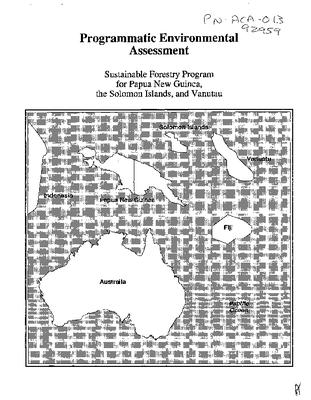Final programmatic environmental assessment: Sustainable forestry program for Papua New Guinea, the Soloman Islands, and Vanuatu
KEYWORD: Community-based Natural Forest Management, Asia. Community-based Natural Forest Management, Australia. Asia, Malaysia, Papua New Guinea, Soloman Islands, Vanutau, community forestry, industrial forestry, logging, market development, sustainable forestry, biodiversity, deforestation, land use, soil conservation, watershed, extension, education, environmental assessment. SUMMARY: In Melanesia, commercial logging has decimated large expanses of forest at the expense of communities that have traditionally depended on forest products. In 1991, the Foundation for the Peoples of the South Pacific (FSP) initiated a program for sustainable community forestry that entailed the use of reduced impact logging methods and small-scale, portable saw mills. The programmatic environmental assessment (PEA) of the program was conducted according to USAID requirements. The PEA analyzed two alternatives: implementation and no implementation of the program. The assessment addressed soil and water resources, forest vegetation, flora and fauna biological diversity, socio-economics, training and extension services, and wood production and marketing. The PEA found that there would be no significant environmental impacts associated with the planned sustainable forestry program as long as safeguards and tree planting mitigation measures were followed and monitoring was conducted diligently. A course of no action would result in many environmental impacts, since industrial logging would then continue unchecked. The authors recommend the following to improve project performance: Harvest planning and designation of conservation zones; Expanding FSP programs by increasing the number of sawmills included and by improving sustainable forestry prescriptions; Training and extension; Land use planning, Market studies to determine means of increasing the profitability of forestry;Increased research of logging impacts on forests,Monitoring and evaluation.
https://biodiversitylinks.org/library/resources/rmp/library/content/tools/biodiversity-support-program/copy_of_cbnfm/USAID-BDB-cd-2-data/final-programmatic-environmental-assessment-sustainable-forestry-program-for-papua-new-guinea-the-soloman-islands-and-vanuatu/view
https://biodiversitylinks.org/library/resources/rmp/library/content/tools/biodiversity-support-program/copy_of_cbnfm/USAID-BDB-cd-2-data/final-programmatic-environmental-assessment-sustainable-forestry-program-for-papua-new-guinea-the-soloman-islands-and-vanuatu/@@download/image/image.png
File
Final programmatic environmental assessment: Sustainable forestry program for Papua New Guinea, the Soloman Islands, and Vanuatu
Author(s):
Senn, R.,
L. Ford,
J. Grant,
D. Schumann,
T. Thake
Location: Papua New Guinea, the Soloman Islands, and Vanuatu
DOWNLOAD FILE
KEYWORD: Community-based Natural Forest Management, Asia. Community-based Natural Forest Management, Australia. Asia, Malaysia, Papua New Guinea, Soloman Islands, Vanutau, community forestry, industrial forestry, logging, market development, sustainable forestry, biodiversity, deforestation, land use, soil conservation, watershed, extension, education, environmental assessment. SUMMARY: In Melanesia, commercial logging has decimated large expanses of forest at the expense of communities that have traditionally depended on forest products. In 1991, the Foundation for the Peoples of the South Pacific (FSP) initiated a program for sustainable community forestry that entailed the use of reduced impact logging methods and small-scale, portable saw mills. The programmatic environmental assessment (PEA) of the program was conducted according to USAID requirements. The PEA analyzed two alternatives: implementation and no implementation of the program. The assessment addressed soil and water resources, forest vegetation, flora and fauna biological diversity, socio-economics, training and extension services, and wood production and marketing. The PEA found that there would be no significant environmental impacts associated with the planned sustainable forestry program as long as safeguards and tree planting mitigation measures were followed and monitoring was conducted diligently. A course of no action would result in many environmental impacts, since industrial logging would then continue unchecked. The authors recommend the following to improve project performance: Harvest planning and designation of conservation zones; Expanding FSP programs by increasing the number of sawmills included and by improving sustainable forestry prescriptions; Training and extension; Land use planning, Market studies to determine means of increasing the profitability of forestry;Increased research of logging impacts on forests,Monitoring and evaluation.



